The official currency of Saudi Arabia is the Saudi Arabian riyal, abbreviated as SAR. The riyal is further divided into 100 halalas, with coins available in denominations of 5, 10, 25, 50, and 100 halalas, and banknotes available in denominations of 1, 5, 10, 20, 50, 100, 200, 500, and 1000 riyals.
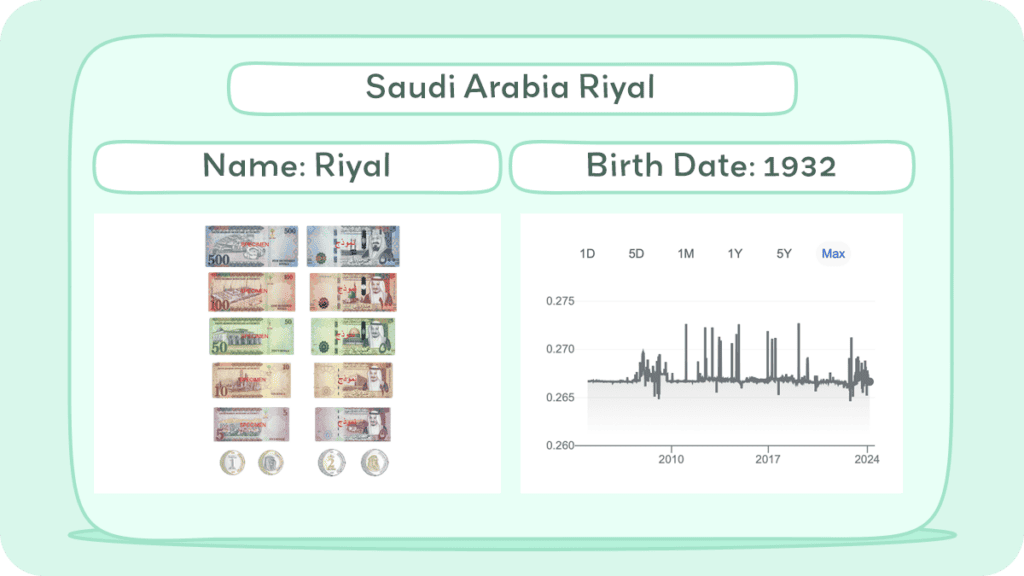
This article explores the historical journey of the Saudi Arabian riyal. From its early roots to its current role in the kingdom’s economy, discover fascinating facts about its design, denominations, and significance in the region’s financial landscape.
Historical Journey of Saudi Arabia Currency
The Saudi riyal has been the currency of Saudi Arabia since its formation in 1932 and was previously used in Hejaz, the most populated region of present-day Saudi Arabia. Initially aligned with the Ottoman 20 kuruş coin, the Hejaz riyal differed in silver content, leading to its unique valuation.
When Saudi Arabia introduced coins denominated in qirsh in 1925, the riyal was subdivided into 22 ghirsh due to its silver content compared to the Ottoman coin. By 1935, the riyal’s value was adjusted to match the silver content of the Indian rupee.
In 1960, the currency system changed to 20 qirsh per riyal, and in 1963, the halala was introduced as one-hundredth of a riyal. Although some coins still show qirsh, it’s rarely used today.
The exchange rate of the Saudi riyal has seen several arrangements since 1936, including a fixed rate for silver and gold, informal and fixed exchange rates to the USD, dual exchange rates, and a peg to special drawing rights (SDR) of the IMF.
Since 1986, the riyal has been pegged to the US dollar at a rate of approximately 3.75 riyals per US dollar, despite earlier fluctuations in its value against silver, gold, and the USD.
The first coins in Saudi Arabia were issued in 1935 by King Abdulaziz Al Saud. These coins were made of silver and featured the king’s portrait on one side and the coat of arms on the other. Since then, the design of the coins has changed several times, with new denominations being added over the years.
Today, the coins in circulation in Saudi Arabia include the 1 halala, 5 halala, 10 halala, 25 halala, 50 halala, and 1 riyal coins. The 1 halala coin is the smallest denomination and is rarely used, while the 1 riyal coin is the largest denomination and is commonly used for larger purchases.
The first paper currency in Saudi Arabia was issued in 1953 by the Saudi Arabian Monetary Agency (SAMA), which was established in 1952. These bills were denominated in riyals and featured the king’s portrait on one side and the coat of arms on the other.
Over the years, the design of the bills has changed several times, with new denominations being added as the economy grew. Today, the bills in circulation in Saudi Arabia include the 1 riyal, 5 riyal, 10 riyal, 20 riyal, 50 riyal, 100 riyal, and 500 riyal bills.
The 500 riyal bill is the largest denomination and is rarely used, while the 1 riyal bill is the smallest denomination and is commonly used for smaller purchases.
History of Coins
Saudi Arabia’s coinage history began in 1925 with the minting of transitional copper coins in Mecca by Ibn Saud. These initial coins were for 1⁄4 and 1⁄2 qirsh (also known as girsh in some regions). The following year, cupro-nickel coins for 1⁄4, 1⁄2, and 1 qirsh were introduced with the title “King of Hejaz and Sultan of Nejd.”
In 1927, with a change in the royal title to “King of Hejaz and Nejd and Dependencies,” new denominations were released in both cupro-nickel for qirsh and silver for riyals.
By 1935, Saudi Arabia issued its first coins under its own name, producing silver coins that were significantly lighter than their predecessors and cupro-nickel qirsh coins starting in 1937. A unique countermarking in 1946 aimed to disrupt the small coin monopoly held by money changers.
The introduction of the halala in 1963 marked a significant shift, with the initial bronze 1 halala coins minted only that year. Cupro-nickel halalas in various denominations came in 1972, and by 1976, 1 riyal cupro-nickel coin was circulating, equivalent to 100 halalas. The currency system advanced with the issuance of bimetallic 1 riyal coins in 1999.
A new coin series was launched in 2016, featuring denominations of 1, 5, 10, 25, and 50 halalas and bimetallic coins for 1 and 2 riyals, modernizing Saudi Arabia’s coinage and reflecting the country’s evolving economic landscape.
History of Bills
Saudi Arabia has had a rich history of banknote issuance, evolving through various series and designs to reflect the country’s leadership and significant events.
Hajj Pilgrim Receipts: Initially issued in 1953 for 10 riyals and later for 1 and 5 riyals, these notes facilitated currency exchange for pilgrims. They became widely accepted and eventually led to the issuance of regular banknotes in 1961 for 1, 5, 10, 50, and 100 riyals. Pilgrim Receipts were phased out in 1965.
Fourth Series (1984–2007): Introduced 500 riyal notes in 1983 and special edition 20 and 200 riyal notes in 2000 to mark the centenary of Saudi Arabia’s founding. This series, featuring King Fahd, remained in circulation alongside subsequent issues.
Fifth Series (2007–2016): Launched with King Abdullah’s portrait on most denominations, this series introduced modern security features to prevent counterfeiting. It included denominations from 1 to 500 riyals, with the 500 riyal note featuring King Abdulaziz.
Sixth Series (2016–present): Features King Salman on denominations from 5 to 100 riyals and King Abdulaziz on the 500 riyal note. In 2020, a polymer 5 riyal note was introduced, offering enhanced durability and security.
Special Banknotes: A commemorative 20 riyal note was released in 2020 to celebrate the G20 summit hosted by Saudi Arabia, featuring a controversial map design. Additionally, a 200 riyal note was introduced in 2021 to highlight Saudi Vision 2030, showcasing modern initiatives and historical sites.
Throughout these series, Saudi banknotes have celebrated the country’s leaders, cultural heritage, and advancements in security technology, while special issues have marked significant national events and goals.
Inflation and Buying Power of Saudi Arabia Currency

The Saudi Arabian riyal (SAR) is the official currency of Saudi Arabia. It is pegged to the US dollar at a fixed exchange rate of 3.75 SAR per USD.
Inflation is an important factor to consider when evaluating the buying power of a currency. According to the Saudi Arabian Monetary Authority, the average annual inflation rate in Saudi Arabia between 1996 and 2023 was 1.94%. This means that the purchasing power of SAR 100 in 1996 equals SAR 167.85 in 2023.
The exchange rate of SAR to USD has remained stable since 1986, but the inflation rate has varied over time. In 2023, the inflation rate in Saudi Arabia was 4.1%, up from 2.3% in 2022. This increase was mainly due to higher prices for food and housing.
To illustrate the impact of inflation on the buying power of SAR, consider the following example. In 1996, a basket of goods that cost SAR 100 would have cost SAR 267.85 in 2023 due to inflation. However, if the exchange rate of SAR to USD had changed during this period, the actual cost in USD would have been different.
Overall, the inflation rate in Saudi Arabia has been relatively low compared to other countries, which has helped to maintain the buying power of the SAR. However, it is still important to consider inflation when evaluating the value of a currency.
Saudi Arabia Currency
The 6th series of Saudi riyal banknotes, issued starting on December 26, 2016, features a range of values, each with distinct colors, designs, and security features:
5 Riyals
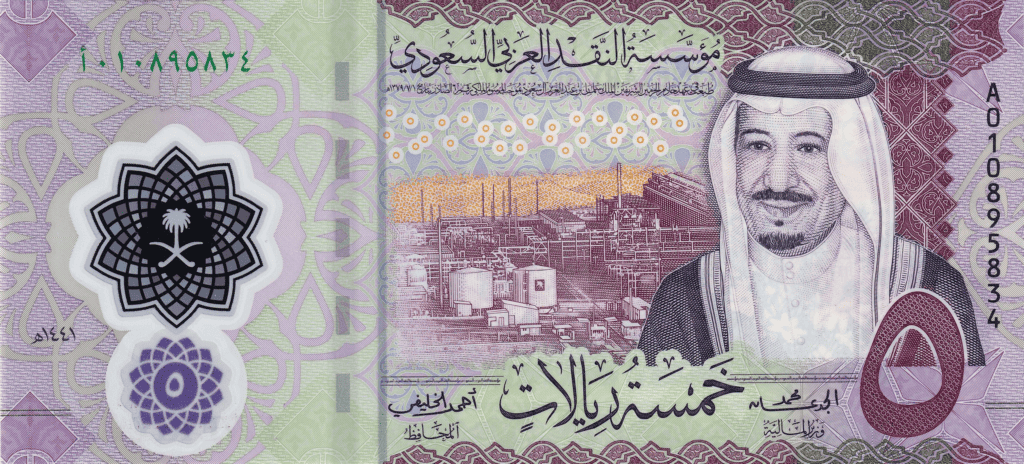
5 Riyals: Measures 145 x 66 mm, colored violet, showcasing the Shaybah oil refinery and flowers on the reverse. Initially released in paper and later in a polymer version on October 4, 2020, it carries watermarks of King Salman and the number 5.
10 Riyals
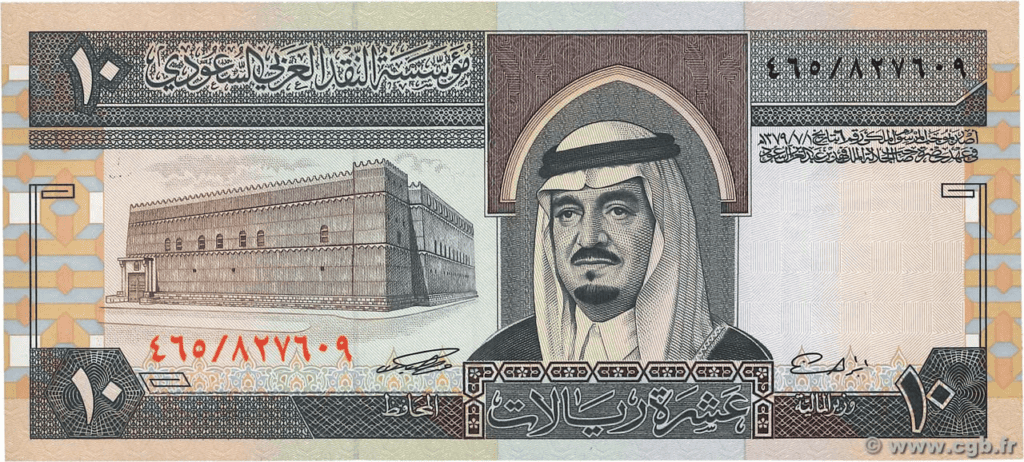
10 Riyals: This brown note measures 150 x 68 mm, with Murabba Palace on the front and the King Abdullah Financial District on the back. It features King Salman and the number 10 as watermarks.
50 Riyals
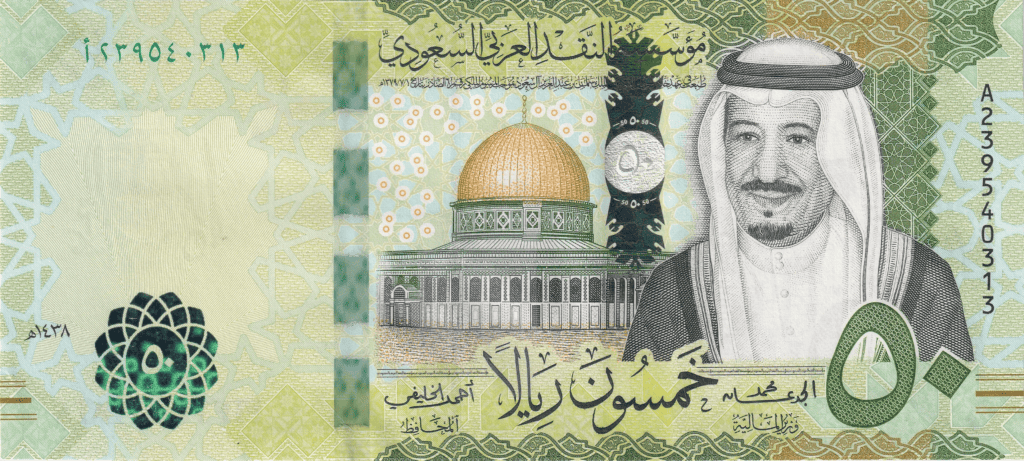
50 Riyals: Green in color and measuring 155 x 70 mm, it depicts the Dome of the Rock in Jerusalem on the obverse and the Al-Aqsa Mosque on the reverse. King Salman and the number 50 serve as watermarks.
100 Riyals
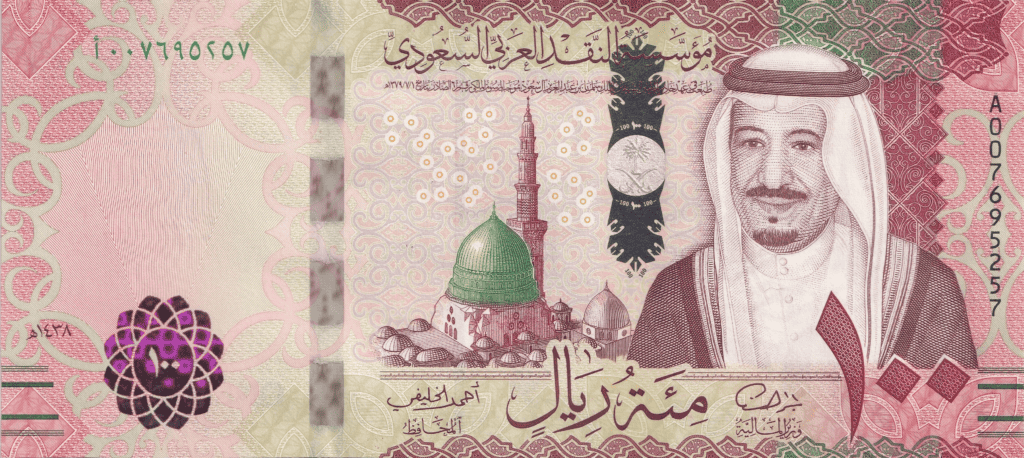
100 Riyals: Red and sized at 160 x 72 mm, it features the Green Dome of The Prophet’s Mosque in Medina on the front and the same mosque’s view on the back. The watermark includes King Salman and the number 100.
500 Riyals
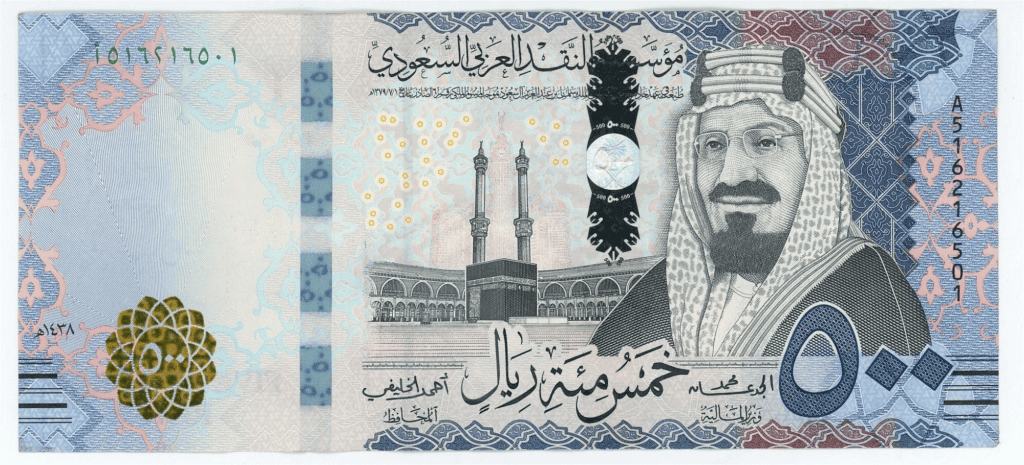
500 Riyals: The largest note, measuring 166 x 74 mm and colored blue, showcases the Ka’aba in Mecca on the front and the Holy Mosque in Mecca on the reverse. King Abdulaziz Al Saud and the number 500 are included as watermarks.
Each banknote in this series carries advanced security features to prevent counterfeiting, highlighting significant Saudi landmarks and leaders.
Currency Usage in Saudi Arabia
If you are planning to visit Saudi Arabia, you will need to know about the country’s currency. The official currency of Saudi Arabia is the Saudi riyal (SAR), which is abbreviated as ر.س or SR. It is divided into 100 halalas, which are abbreviated as هللة.
Is USD accepted in Saudi Arabia?
While the Saudi riyal is the official currency, the US dollar (USD) is also widely accepted in Saudi Arabia. However, it is recommended that you exchange your USD to SAR to avoid any confusion or potential issues with exchange rates.
You can exchange your currency at airports, banks, and exchange offices throughout the country. Some hotels also offer currency exchange services, but their rates may not be as favorable as those at banks or exchange offices.
When using your credit or debit card in Saudi Arabia, it is important to check with your bank beforehand to ensure that your card will work in the country. Some banks may charge a foreign transaction fee for using your card abroad, so it is important to check with your bank to avoid any surprise fees.
Exchanging Currency in Saudi Arabia
If you are planning to visit Saudi Arabia, it is essential to know the ins and outs of exchanging currency in the country. Here are some important things you need to know before exchanging your currency.
Where can I exchange Saudi Arabia currency?
You can exchange your currency at banks, exchange offices, or hotels. Banks are the most reliable and secure option, and they usually offer the best exchange rates. Some of the major banks in Saudi Arabia include Al Rajhi Bank, National Commercial Bank, and Riyad Bank.
Exchange offices are also a good option, but make sure to compare rates before exchanging your currency. Hotels also offer currency exchange services, but they usually have lower exchange rates and higher fees.
What to know before exchanging currency in Saudi Arabia
Before exchanging your currency, here are some important things you need to know:
- Exchange rates: Make sure to check the exchange rate before exchanging your currency. Exchange rates may vary depending on the institution you choose, so compare rates to get the best deal.
- Fees: Some institutions charge fees for exchanging currency. Make sure to ask about any fees before exchanging your currency.
- Identification: You will need to provide identification, such as a passport or ID, when exchanging your currency.
- Currency restrictions: Some countries have restrictions on the amount of currency you can bring in or take out of the country. Make sure to check the restrictions before traveling to Saudi Arabia.
Exchanging currency in Saudi Arabia can be a simple and straightforward process if you know what to expect. By following these tips, you can ensure that you get the best exchange rate and avoid any issues when exchanging your currency.
Choosing Between USD and Saudi Arabia Currency
When traveling to Saudi Arabia, you will need to decide whether to use USD or the local currency, Saudi Arabian riyals (SAR). Here are some factors to consider when making your decision:
Exchange Rate
The exchange rate between USD and SAR fluctuates regularly. It is important to check the current exchange rate before making any transactions. Keep in mind that currency exchange services may charge a fee for converting your currency.
Convenience
While USD is widely accepted in major cities in Saudi Arabia, it may not be accepted in smaller towns or for smaller transactions. It is recommended to carry some SAR for smaller purchases such as food or souvenirs. ATMs are widely available in Saudi Arabia, so withdrawing SAR should not be a problem.
Fees
When using a credit or debit card in Saudi Arabia, you may be charged a foreign transaction fee by your bank. It is important to check with your bank to see what fees may apply. Additionally, currency exchange services may charge a fee for converting your currency.
Tips
When traveling to Saudi Arabia, it is important to be aware of cultural norms and customs. Tipping is not expected in many places, but it is appreciated in some situations such as at restaurants or for hotel staff. It is recommended to carry some small bills in SAR for tipping purposes.
Overall, it is recommended to carry both USD and SAR when traveling to Saudi Arabia. While USD is widely accepted, having some SAR on hand will make smaller transactions more convenient. It is important to check the exchange rate and be aware of any fees that may apply when making transactions.
Cost of Living in Saudi Arabia
If you are planning to move to Saudi Arabia, it is important to understand the cost of living in the country. The cost of living in Saudi Arabia is generally lower than in many western countries, but it can vary depending on the city you are living in and your lifestyle.
According to Numbeo, a family of four can expect to spend around $2,873.2 (10,776.0﷼) per month without rent. A single person can expect to spend around $803.8 (3,014.6﷼) per month without rent. These estimates include expenses such as groceries, transportation, and entertainment.
Here are some estimated costs of common expenses in Saudi Arabia as of February 2024, according to Numbeo:
- Milk (regular, 1 gallon): 1.35﷼
- Loaf of Fresh White Bread (1 lb): 24.35﷼
- Mobile Phone Monthly Plan with Calls and 10GB+ Data Internet (60 Mbps or More, Unlimited Data, Cable/ADSL): 3.69﷼
Keep in mind that these are just estimates and actual costs may vary depending on where you live and your lifestyle. It is also important to note that the cost of living in Saudi Arabia may be higher for expats due to the higher cost of imported goods.
Overall, the cost of living in Saudi Arabia is generally lower than in many western countries, but it is important to research and budget accordingly to ensure that you can afford the expenses associated with living in the country.
Don’t Get Scammed Tips
When traveling to a foreign country, it’s important to be aware of the currency and any potential scams that may target tourists. Here are some tips to help you avoid being scammed when dealing with Saudi Arabia currency:
1. Familiarize Yourself with the Security Features
The Saudi Arabian Monetary Authority (SAMA) has implemented specific security features on the new denominations of the Saudi riyal banknotes to protect against counterfeit and fraud.
Familiarize yourself with these security features before handling any currency. You can find more information on these security features on the SAMA website here.
2. Use Licensed Money Changers
When exchanging currency, it’s important to use licensed money changers to avoid being scammed. You can find licensed money changers at banks, hotels, and exchange bureaus. Be wary of individuals offering to exchange currency on the street, as they may offer counterfeit currency or use sleight of hand to trick you.
3. Check Your Change Carefully
When making purchases, always check your change carefully to ensure that you are receiving the correct amount. Be wary of individuals who claim to have no change and offer to give you a larger bill instead. This is a common scam used to give tourists counterfeit currency.
4. Avoid Using Credit Cards at Small Shops
While credit cards are widely accepted in larger stores and restaurants, it’s best to avoid using them at small shops and street vendors. These vendors may use skimming devices to steal your credit card information. Instead, carry cash and only use credit cards at reputable establishments.
5. Be Wary of ATMs
When using ATMs, be wary of skimming devices that may be attached to the machine. Always cover the keypad when entering your PIN and check the machine for any signs of tampering. If you notice anything suspicious, report it to the bank immediately.
By following these tips, you can avoid being scammed when dealing with Saudi Arabia currency. Remember to always be vigilant and use common sense when handling money in a foreign country.

